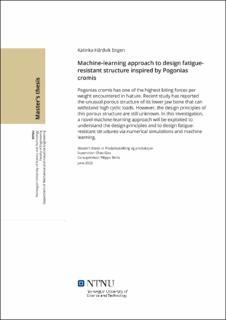Machine-learning approach to design fatigue-resistant structure inspired by Pogonias cromis
Master thesis
Permanent lenke
https://hdl.handle.net/11250/3021080Utgivelsesdato
2022Metadata
Vis full innførselSamlinger
Sammendrag
Atlanterhavsfisken Pagonias cromis har den høyeste bitekraften per vekt, men det nedre svelgkjevebenet som er ansvarlig for å knuse bløtdyr og skalldyr er relativt porøst sammenlignet med kortikalt bein funnet i pattedyr. I denne oppgaven blir mikrostrukturen til dette beinet bli utforsket for om det inneholder egenskaper som gjør det spesielt egnet til å motstå utmattelsesskader. Det vil også bli undersøkt om dette problemet effektivt kan automatiseres og modelleres ved hjelp av maskinlæringsverktøy og optimaliseringsmetoden 'differential evoulution'.
Resultatene viser at bruk av nevrale nettverk for å undersøke variabel signifikans i strukturen er mulig med riktige kalibreringer, og modell, og en effektiv fremgangsmåte. Optimalisering ved bruk av differensiell evolusjon var svært effektiv kombinert med regresjonsmodell estimert med nevralt nettverk. På grunn av de begrensede tilgjengelige beregningsressursene var den ikke like robust kombinert med Abaqus, siden den ikke håndterte avbrudd uten å måtte starte på nytt. Studien viste også at faktorene som beskriver mikrostrukturen i betydelig grad påvirker strukturenes evne til å motstå tretthetsvrudd. For fast spenning må det kjøres ytterligere simuleringer for å gi et avgjørende svar på hva som er den optimale strukturen. The Black Drum fish has the highest biting force per weight, yet its lower pharyngeal jaw bone responsible for crushing the mollusks and shellfish is relatively porous compared to cortical bone found in mammalian bone. In this thesis, the microstructure of this bone will be investigated to find whether it contains properties making it especially suitable to withstand cyclic fatigue damage. It will also be investigated whether this problem can be effectively automized and modeled using machine learning tools and optimization differential evolution.
The results show that using neural networks to examine variable significance in the structure is an efficient method, possibly with the correct calibrations and inputs and outputs. Optimization using differential evolution was very efficient combined with a regression model obtained with a neural network. Due to the limited available computational resources, it was not as robust in combination with Abaqus, as it did not handle interruptions without having to restart. The study also showed that the micro structure's factors significantly affect the structures' ability to withstand fatigue. For fixed stress, further simulations must be run to give a conclusive answer to what is the optimal structure.
